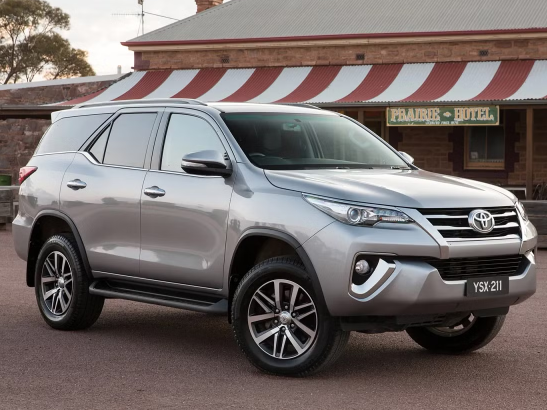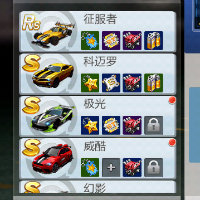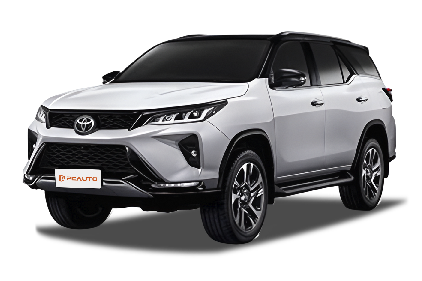Q
What is the fuel economy of Fortuner 2021?
The 2021 Toyota Fortuner's fuel economy in the Malaysian market varies depending on the powertrain. Models with the 2.7-liter petrol engine return a combined fuel consumption of around 10-11 km/l, while the more efficient 2.8-liter turbocharged diesel version achieves a combined 12-14 km/l. Actual figures may vary slightly based on driving habits, road conditions, and vehicle load. As a 7-seater SUV focused on durability and off-road capability, the Fortuner strikes a balance between power needs and practicality, with the diesel variant particularly suited for long-distance driving or frequent heavy loading. It's worth noting that Malaysian consumers should also consider the impact of local fuel quality (such as RON95 or diesel standards) on engine efficiency when evaluating fuel consumption. Regular maintenance, like air filter replacements and tire pressure checks, can also effectively optimize fuel economy. For those seeking better fuel efficiency, keep an eye on the vehicle's ECO driving mode, which enhances efficiency by adjusting throttle response and shift logic. However, the fuel consumption of such a large SUV is naturally higher than that of urban SUVs, so it's advisable to weigh power and fuel efficiency needs based on actual usage before purchasing.
Special Disclaimer: This content is published by users and does not represent the views or position of PCauto.
Related Q&A
Q
Is the Toyota Fortuner bumpy?
When it comes to whether the Toyota Fortuner rides rough, the SUV's comfort level mainly depends on its suspension setup and the road conditions. The Fortuner features a body-on-frame construction and a rear solid axle suspension design – this setup provides better rigidity for off-roading, but it can transmit more road vibrations when driving on regular paved roads, especially noticeable for rear passengers. However, Toyota engineers have optimized it for city driving, so it's already more comfortable than a pure off-road vehicle. If you find the suspension too stiff, you can check if the tire pressure is too high or consider switching to tires better suited for highway driving. Malaysian consumers should note that there are slight differences in suspension tuning across different model years of the Fortuner; post-2016 facelift models saw improvements in comfort. Additionally, the vehicle's load capacity also affects suspension performance. It's recommended to test drive the vehicle yourself before purchasing and compare it with other SUVs in its class. After all, each model has unique suspension characteristics, and the key is to choose the one that best fits your daily usage needs.
Q
What is the difference between Fortuner and legender?
The Toyota Fortuner and Legender are two SUVs with distinct positioning, differing mainly in design and features. The Legender can be seen as the premium, upgraded version of the Fortuner. As Toyota's main seven-seater SUV in Southeast Asia, the Fortuner focuses on practicality and off-road capability, featuring a body-on-frame construction and part-time 4WD system—ideal for family trips or light off-roading. Meanwhile, the Legender, built on the Fortuner platform, boasts a sleeker, sportier look with a blacked-out grille, LED headlights, and exclusive wheel designs. Its interior uses higher-quality materials and adds tech touches like a full digital instrument cluster, targeting a urban luxury vibe. Notably, it only offers a five-seat layout to enhance rear passenger comfort and space. Both share the 2.8L turbo diesel engine, but the Legender’s tuning prioritizes a smoother driving experience. For Malaysian buyers, the Fortuner makes sense if you value affordability and versatility, while the Legender better suits those craving personality and premium features. It’s worth mentioning that this "twin-model" strategy is common for Toyota in Southeast Asia—similar to the Hilux and Hilux Rogue—using differentiated designs to cater to diverse customer groups while sharing platforms to cut production costs.
Q
What are common problems with the 2021 Fortuner?
The 2021 Toyota Fortuner has generally proven reliable in the Malaysian market, though some owners have reported a few common issues. For instance, diesel engine variants might experience brief shaking during cold starts, which is usually linked to the local humid climate or fuel quality. It's advisable to regularly replace the fuel filter and use the recommended diesel grade. Some owners have also mentioned that the third-row seating feels a bit cramped, with average comfort for long journeys—this is a typical design trade-off seen in most seven-seat SUVs. Additionally, there are a small number of cases where the infotainment system occasionally freezes, which can be fixed with a software update. Notably, while the Fortuner's body-on-frame construction ensures off-road durability, the suspension tuning feels on the stiffer side when driving on paved roads, a characteristic trait of rugged SUVs. Malaysian owners are advised to pay special attention to regular checks of the chassis rubber components, as the local rainy climate may accelerate wear on these parts. Overall, these issues fall within the normal range for vehicles in this class, and adhering to scheduled official maintenance can effectively prevent them. For consumers considering a used model, it’s recommended to focus on inspecting the 4WD system’s functionality and chassis rust conditions—areas that require extra attention in Malaysia’s humid environment.
Q
Does the 2021 Fortuner have Apple CarPlay?
The 2021 Toyota Fortuner does come with Apple CarPlay in the Malaysian market. This feature lets drivers seamlessly connect their iPhones to the infotainment system, giving them access to navigation, music, calls, and other apps—definitely a boost for both convenience and in-car entertainment. As a popular SUV among Malaysian buyers, the Fortuner's tech features have always kept up with market demands. Besides Apple CarPlay, some variants might also support Android Auto to cater to different smartphone users. It's worth noting that specific features can vary depending on the trim level or regional specifications, so it's a good idea to check the exact specs with dealers before buying. Plus, with the rapid growth of in-car connectivity, more and more models are adding smart features like voice control and wireless connectivity. These tech upgrades not only make driving safer and easier but also show how the auto industry is moving toward digitalization and smart technology. For Malaysian consumers, picking a car with an advanced infotainment system isn't just about meeting daily needs—it also ensures the vehicle stays practical for years to come.
Q
Why did Toyota stop making the Fortuner?
Toyota's decision to stop producing the Fortuner mainly stems from market strategy and product line optimization. As consumer demands evolve and environmental regulations become increasingly stringent, Toyota is shifting resources toward models that better align with current market trends, such as hybrid and fully electric SUVs, to meet the global demand for energy-efficient and eco-friendly vehicles, including in markets like Malaysia. While the Fortuner, as a traditional fuel-powered SUV, was once highly popular in Southeast Asia, intensifying market competition and shifting consumer preferences have likely led Toyota to focus on more forward-looking products. Additionally, Toyota's newer SUV models like the RAV4 and Highlander, with their more advanced technology and features, have gradually taken over the Fortuner's market position. For Malaysian consumers, while the discontinuation of the Fortuner may be disappointing, Toyota still offers other excellent SUV options, such as the durable and reliable Hilux and the premium and comfortable Land Cruiser, which are well-suited to Malaysia's road conditions and driving needs. Looking ahead, Toyota will likely continue to launch more models tailored to the local market to cater to consumers' diverse demands.
Q
What is the Fortuner facelift 2021?
The 2021 Toyota Fortuner facelift is Toyota's updated mid-size SUV for the Southeast Asian market, with tweaks focused on exterior styling, interior upgrades, and tech features. On the outside, it gets sharper LED headlamps, a brand new designed front grille, and sportier front and rear bumpers. Inside, there's improved soft-touch materials and nicer trim, plus a touchscreen that supports Apple CarPlay and Android Auto. Under the hood, it carries over the 2.7-liter petrol and 2.8-liter turbo diesel engine options, mated to a 6-speed automatic transmission, with 4WD available on some variants. This SUV is pretty popular in Malaysia – its durability and off-road capability make it a good fit for the country's diverse road conditions. As a key Toyota model in Southeast Asia, every Fortuner update includes tweaks tailored to tropical climates and local roads, like better aircon performance and a tougher chassis. For Malaysian buyers eyeing a 7-seater SUV, it's a practical pick that balances family use and outdoor adventures. Rivals in its class include the Mitsubishi Pajero Sport and Isuzu MU-X, but the Fortuner holds strong market appeal thanks to Toyota's brand reputation and well-established after-sales network.
Q
What is the update for Fortuner 2021?
Toyota launched the facelifted Fortuner in the Malaysian market in 2021, focusing on upgrades to its exterior, interior, and features. On the outside, it gets a newly designed grille, LED headlamps and taillights, plus fresh wheel designs, giving the overall look a more stylish and dynamic vibe. Inside, the center console has been revamped, fitted with a larger touchscreen and an updated infotainment system that supports Apple CarPlay and Android Auto, boosting both tech appeal and practicality. In terms of safety, the Toyota Safety Sense suite comes standard across the range, including pre-collision system, lane departure alert, adaptive cruise control, and more, further enhancing driving safety. Under the hood, it continues with the 2.7-liter petrol and 2.8-liter turbo diesel engines, mated to a 6-speed automatic gearbox, with 4WD available on some variants to meet different customer needs. For Malaysian buyers, the Fortuner has long been known for its reliability, durability, and off-road capability, making it a great fit for the country's varied road conditions and family use. The facelifted model builds on those strengths with exterior and feature upgrades, keeping it competitive and still a solid pick in the midsize SUV segment.
Q
What are the common problems with Fortuners?
The Toyota Fortuner, a popular SUV in the Malaysian market, has its common issues mainly centered around the stiff suspension setup, which compromises long-distance comfort—rear passengers especially may feel the bumps on rough roads, a trade-off for its off-road-focused tuning. Some owners report that the 2.7L petrol engine delivers rather flat torque at low revs, making it better suited for city driving; if you frequently carry heavy loads or tackle hills, the 3.0L diesel variant is a smarter pick. Inside, the plastic dashboard trim can sometimes creak in hot weather, but regular treatment with rubber protectant helps reduce the noise. Electronic components like the reverse camera might temporarily fail due to moisture during the rainy season, so keeping the connectors sealed should prevent that. It’s worth noting the Fortuner’s high ground clearance takes some getting used to for new drivers when getting in and out, but it also gives it an impressive 700mm water-wading capability—perfect for Malaysia’s rainy climate. Regularly replacing the original shock absorbers and transmission fluid (every 40,000 km is recommended) can significantly extend the chassis lifespan, and with Toyota’s 5-year warranty covering most mechanical parts, sticking strictly to the maintenance manual is the best way to keep it running in top shape.
Q
What is the warranty on a Toyota 2021?
According to Toyota Malaysia's official policy, the 2021 Toyota models come with a 5-year unlimited mileage factory warranty. This covers major mechanical components such as the engine, transmission, and drive system. New cars also include complimentary maintenance services, with the specific number of visits depending on the model, typically ranging from 3 to 5 regular services. It's important to note that warranty terms require owners to carry out regular maintenance at authorized service centers as per official regulations; otherwise, warranty benefits may be affected. For hybrid models, the high-voltage battery pack usually comes with an additional warranty of 8 years or a specific mileage, whichever comes first. Malaysia's hot and rainy climate can cause significant wear and tear on vehicles. In addition to keeping an eye on the warranty period, owners are advised to pay special attention to regular checks of climate-vulnerable components like the air conditioning system, rubber seals, and chassis rust protection. Toyota has an extensive after-sales service network in Malaysia, and owners can conveniently book maintenance and check warranty status through the MyToyoTA app.
Q
How many kilometers can a Fortuner run in a full tank?
The Toyota Fortuner's full-tank range depends on the specific model and driving conditions. Generally, the 2.7-liter gasoline engine version has an 80-liter fuel tank and averages around 10-12 liters per 100 kilometers in mixed driving, so you're looking at roughly 650-800 kilometers on a full tank. The 2.8-liter diesel engine model has the same tank size but is more fuel-efficient, sipping about 7-9 liters per 100 kilometers, pushing the range up to 900-1100 kilometers. Your actual mileage will vary based on driving habits, road conditions, and payload—highway cruising keeps fuel consumption lower, while stop-and-go city traffic will eat into that range. We recommend regular vehicle maintenance: keeping tires properly inflated, cleaning out carbon deposits, those little things really help optimize fuel efficiency. Also, in Malaysia's hot weather, running the AC for extended periods can crank up fuel use, so using the air conditioning system wisely can also have a positive impact on how far you can go.
Latest Q&A
Q
What is the difference between the 2024 and 2025 BMW 5 Series?
There are some differences between the 2024 and 2025 BMW 5 Series models. In terms of pricing, the 2024 520i starts at RM 332,800, with the 520i M Sport variant coming in at RM 349,800. The 2025 530i M Sport, on the other hand, is priced at RM 399,800.
Under the hood, the 2024 520i engines deliver either 210PS or 208PS, while the 2025 530i M Sport ups the ante with a 258PS powerplant. Performance-wise, the 2024 models top out at 230km/h and sprint from 0-100km/h in 7.5 seconds. The 2025 model pushes that top speed to 250km/h and shaves the 0-100km/h time down to just 6.2 seconds.
Looking at the specs, some 2024 trims have rear seats with manual adjustments or fixed configurations, whereas the 2025 model gets a 40:20:40 split-folding rear seat setup. Audio systems also see an upgrade: most 2024 models feature Harman Kardon speakers, while the 2025 model steps up to a Bowers & Wilkins surround sound system.
Additionally, the 2025 5 Series hit dealerships on March 13, 2025, and comes with a 2-year unlimited mileage warranty. The 2024 models first arrived on September 2, 2024.
Q
How much is insurance for a 2024 BMW 5 Series?
The insurance cost for the 2024 BMW 5 Series in Malaysia varies based on several factors, typically ranging from RM5,000 to RM15,000 annually. The exact amount depends on the vehicle model (such as 520i, 530e, or M550i), engine displacement, the owner's age, driving record, type of policy (comprehensive or third-party), and the insurance company's discount policies. For instance, the high-performance M550i, with its higher repair costs, will have significantly higher premiums than the entry-level 520i, while the hybrid 530e may qualify for partial insurance discounts due to its eco-friendly features. Additionally, Malaysia's insurance market is influenced by the No Claim Discount (NCD), where drivers with consecutive claim-free years can enjoy a maximum 55% reduction in premiums. It's advisable to obtain accurate quotes through insurance company websites or comparison platforms before purchasing a car, and also to understand the additional services offered by Malaysian car insurance, such as roadside assistance or windscreen coverage, as these details can impact the final decision. Notably, luxury car insurance usually includes higher third-party liability coverage limits to comply with local regulatory requirements, and owners can also adjust the excess amount according to their needs to balance premium costs.
Q
What is the maintenance cost of a 2024 5 Series?
The maintenance costs for the 2024 BMW 5 Series in Malaysia can vary depending on the specific model and driving habits, but generally speaking, the regular servicing fees for the first 3 years of a new car are roughly between RM3,000 to RM5,000 per year. This depends on the chosen original maintenance package and the actual mileage driven. BMW offers various maintenance plan in Malaysia, allowing owners to opt for one-time payment or installment plans. These packages typically cover basic items like oil changes, filter replacements, and brake inspections. If the vehicle is equipped with more high-tech features, such as active suspension or a hybrid system, the long-term maintenance costs might be slightly higher. However, BMW's after-sales service network in Malaysia is quite comprehensive, with many authorized service centers capable of providing professional maintenance and repair services. To reduce long-term ownership costs, it's advisable for owners to follow the manufacturer's recommended regular maintenance schedule and use genuine parts. This not only extends the vehicle's lifespan but also helps maintain a good resale value. Additionally, given Malaysia's hot and humid climate, owners should pay extra attention to maintaining the air conditioning system and battery to ensure the vehicle always stays in optimal condition.
Q
How much is a used BMW 5 Series 2024?
In the current Malaysian market, used 2024 BMW 5 Series models aren't widely available yet due to the new car's relatively recent launch. However, based on the market trends for used BMW 5 Series of similar model years and conditions, prices typically range from RM250,000 to RM350,000. The exact price depends on factors like trim level, mileage, maintenance history, and whether the original factory warranty is still valid. For instance, higher-spec models like the 530i M Sport might be closer to the upper end of that range, while entry-level variants such as the 520i would be relatively lower. When buying a used car, it's advisable to go through officially certified pre-owned channels or reputable dealerships to ensure the vehicle has undergone rigorous inspection and comes with warranty coverage. Additionally, the BMW 5 Series is renowned for its luxurious interior, advanced technology, and driving dynamics – the 2024 model, in particular, likely features the updated iDrive system and mild-hybrid technology, which also influence used prices. In Malaysia, used car prices can also be affected by import duties, road tax, and insurance costs, so it's recommended to thoroughly assess the total cost of ownership and compare different car sources to get the best value for money before making a purchase.
Q
How many BMW 5 Series sold in 2024?
As of 2024, official sales figures for the BMW 5 Series in Malaysia haven't been formally released yet. But looking at BMW Malaysia's past market performance and industry trends, this luxury sedan has always maintained steady demand locally, especially thanks to its blend of sporty performance and business luxury that really resonates with local buyers. For 2024, the BMW 5 Series has rolled out more eco-friendly powertrain options, like plug-in hybrid models, which should further appeal to buyers who want both efficiency and high performance. In the Malaysian market, luxury car sales are usually influenced by the economic environment, consumption tax policies, and brand promotional activities. Interested consumers are advised to follow BMW Malaysia's official website or authorized dealers for the latest and most accurate information. Additionally, as a representative of mid-size luxury sedans, the BMW 5 Series competes with models like the Mercedes-Benz E-Class and Audi A6, which also have a strong presence in the Malaysian market. Consumers can make a comprehensive comparison based on personal preferences and budget.
View MoreRelated News

Toyota Fortuner: Spacious 7-Seater Layout, the Ideal Choice for Family Travel
AshleyMay 4, 2025

Why are people more willing to choose Toyota Hilux instead of Isuzu D-Max?
JamesNov 3, 2025

In Malaysia, which sliding door MPVs are available?
MichaelOct 30, 2025

Toyota Land Cruiser FJ did not disappoint, the most anticipated civilian off-road vehicle is back.
Kevin WongOct 21, 2025

Toyota bZ3X launched in Hong Kong and will continue to expand to other right-hand drive markets in the future
JamesOct 21, 2025
View More

















Pros
Cons